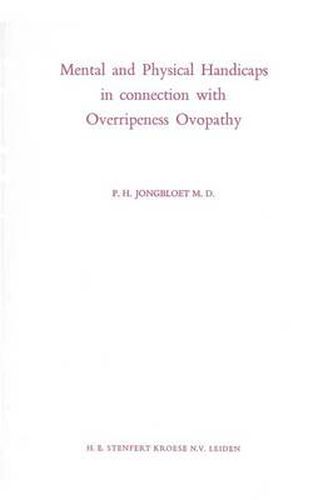Readings Newsletter
Become a Readings Member to make your shopping experience even easier.
Sign in or sign up for free!
You’re not far away from qualifying for FREE standard shipping within Australia
You’ve qualified for FREE standard shipping within Australia
The cart is loading…






This title is printed to order. This book may have been self-published. If so, we cannot guarantee the quality of the content. In the main most books will have gone through the editing process however some may not. We therefore suggest that you be aware of this before ordering this book. If in doubt check either the author or publisher’s details as we are unable to accept any returns unless they are faulty. Please contact us if you have any questions.
Parents of children born with mental or physical handicaps, tend to face the physician with questions about the origin of the abnormality concerned and the chance of having another child with the same condition. The physician then finds himself in a difficult situation since the causes of the majority of congenital abnormalities remain as yet unknown. In most cases he has to restrict himself to a mere enumeration of the signs and symptoms encountered or, at best, to a classification of the syndrome at hand. Efforts are frequently made to connect both the somatic aberrations and the mental deficiency with complications during the later stages of pregnancy, at the time of delivery or in the immediate postnatal period. However, a careful search for such items as abnormal dermatoglyphs, or ‘degenerative stigmata’, and, in particular, a post-mortem examination of the brain, often indicates that the handicap concerned should be ascribed to factors operating long before the time of birth. Theoretically, the causes of abnormalities present at birth can be listed as of a genetic, germinal or peristatic nature. During the past decades special attention has been paid to both genetic and peristatic factors. The purpose of this thesis is to stress the importance of germinal factors, in particular those which, at least in theory, might lead to disturbances in the ripening process of the human egg. We were put on this track by some data concerning the circumstances under which one of our patients presumably had been conceived.
$9.00 standard shipping within Australia
FREE standard shipping within Australia for orders over $100.00
Express & International shipping calculated at checkout
This title is printed to order. This book may have been self-published. If so, we cannot guarantee the quality of the content. In the main most books will have gone through the editing process however some may not. We therefore suggest that you be aware of this before ordering this book. If in doubt check either the author or publisher’s details as we are unable to accept any returns unless they are faulty. Please contact us if you have any questions.
Parents of children born with mental or physical handicaps, tend to face the physician with questions about the origin of the abnormality concerned and the chance of having another child with the same condition. The physician then finds himself in a difficult situation since the causes of the majority of congenital abnormalities remain as yet unknown. In most cases he has to restrict himself to a mere enumeration of the signs and symptoms encountered or, at best, to a classification of the syndrome at hand. Efforts are frequently made to connect both the somatic aberrations and the mental deficiency with complications during the later stages of pregnancy, at the time of delivery or in the immediate postnatal period. However, a careful search for such items as abnormal dermatoglyphs, or ‘degenerative stigmata’, and, in particular, a post-mortem examination of the brain, often indicates that the handicap concerned should be ascribed to factors operating long before the time of birth. Theoretically, the causes of abnormalities present at birth can be listed as of a genetic, germinal or peristatic nature. During the past decades special attention has been paid to both genetic and peristatic factors. The purpose of this thesis is to stress the importance of germinal factors, in particular those which, at least in theory, might lead to disturbances in the ripening process of the human egg. We were put on this track by some data concerning the circumstances under which one of our patients presumably had been conceived.